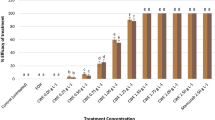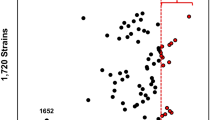Abstract
Colletotrichum kahawae is the causal agent of coffee berry disease. Appressorial melanization is essential for the fungal penetration of plant cuticle. Epicatechin is abundant in green coffee berry pericarp. Inoculation of C. kahawae conidial suspension containing 1.2 mg epicatechin or catechin/ml did not affect conidial germination or appressorial formation but appressorial melanization was completely inhibited and infection by the treated conidia was less than 30% of the untreated control. Epicatechin and catechin may, therefore, prevent coffee berry disease by inhibition of the appressorial melanization of C. kahawae.
Similar content being viewed by others
References
Bechinger C, Giebel KF, Schnell M, Leiderer P, Deising HB, Bastmeyer M (1999) Optical measurements of invasive forces exerted by appressoria of a plant pathogenic fungus. Science 285:1896–1899
Chen ZJ, Liang JS, Rodrigues CJ Jr (2005) Colletotrichum gloeosporioides can overgrow Colletotrichum kahawae on green coffee berries first inoculated with C. kahawae. Biotechnol Lett 27:679–682
Chen ZJ, Nunes MA, Silva MC, Rodrigues CJ Jr (2004) Appressoria turgor pressure of Colletotrichum kahawae might have a role in coffee cuticle penetration. Mycologia 96:1199–1208
Hirasawa M, Takada K (2004) Multiple effects of green tea catechin on the antifungal activity of antimycotics against Candida albicans. J Antimicrob Chemoth 53:225–229
Niu X, Fan X, Sun J, Ting P, Narula S, Lundell D (2004) Inhibition of fucosyltransferase VII by gallic acid and its derivatives. Arch Biochem Biophys 425:51–57
Prusky D, Kobiler I, Jacoby B (1988) Involvement of epicatechin in cultivar susceptibility of avocado fruits to Colletotrichum gloeosporioides after havest. J Phytopathol 123:140–146
Ramirez-Martinz JR (1988) Phenolic compounds in coffee pulp: quantitative determination by HPLC. J Sci Food Agric 43:135–144
Thines E, Weber RWS, Talbot NJ (2000) MAP kinase and protein kinase a-dependent mobilization of triacylglycerol and glycogen during appressorium turgor generation by Magnaporthe grisea. Plant Cell 12:1703–1718
Tonukari NJ, Scott-Craig JS, Walton JD (2000) The Cochliobolus carbonum SNF1 gene is required for cell wall-degrading enzyme expression and virulence on maize. Plant Cell 12:237–248
Author information
Authors and Affiliations
Corresponding author
Rights and permissions
About this article
Cite this article
Chen, Z., Liang, J., Zhang, C. et al. Epicatechin and catechin may prevent coffee berry disease by inhibition of appressorial melanization of Colletotrichum kahawae . Biotechnol Lett 28, 1637–1640 (2006). https://doi.org/10.1007/s10529-006-9135-2
Received:
Accepted:
Published:
Issue Date:
DOI: https://doi.org/10.1007/s10529-006-9135-2




